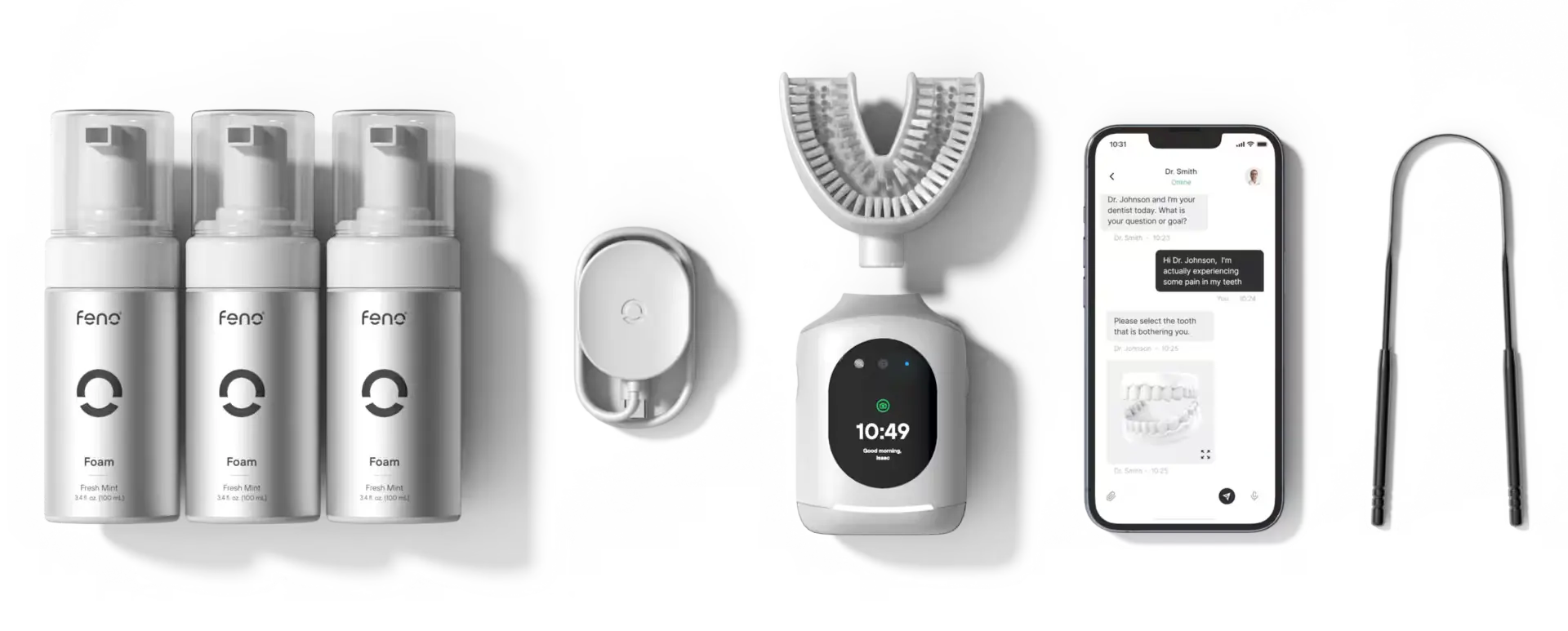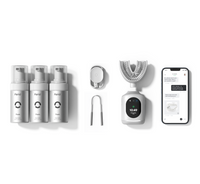
11 min read
Say Goodbye to Bleeding Gums: Smarter Ways to Brush
Bleeding gums can be a wake-up call for many people. Often, they are not just a result of brushing too hard. Instead, they might be early signs of gum disease, like gingivitis or even periodontitis. These conditions develop when plaque builds up along the gumline, irritating the gums and causing them to bleed. This irritation can lead to more serious issues, such as receding gums and tooth loss. When they bleed regularly, it’s your body’s way of telling you something is wrong. To stop bleeding gums, understanding their root cause is the first step toward better oral health.
Gentle Brushing Techniques for Healthier Gums
How to Use the Bass Method
This technique involves placing the toothbrush at a 45-degree angle where the teeth meet the gums. Rather than scrubbing, you make small, gentle back-and-forth motions. These micro-movements allow the bristles to reach just below the gumline, where plaque and bacteria often hide. This method prioritizes precision and gentleness. By focusing on technique, you reduce the risk of damaging gum tissue. Using the Bass Method consistently helps remove buildup before it turns into tartar. Adopting this approach is one of the most valuable oral hygiene tips to start with today.
Soft-Bristle Electric Toothbrushes
Brushing with circular strokes is more effective for gum health than sawing back and forth. When combined with a soft-bristle electric toothbrush, these gentle circles can clean thoroughly while minimizing friction. Many people unknowingly scrub in straight lines, which can lead to surface wear and gum discomfort over time. Rotating the brush in small circles helps lift debris away from the teeth and gumline. Soft bristles flex to reach tricky areas without scratching enamel or irritating soft tissues. This combination supports both cleanliness and comfort. Electric models that emphasize these movements allow you to clean your mouth thoroughly while staying kind to your gums.
Avoiding Overbrushing and Gum Abrasion
Overbrushing refers to brushing with excessive pressure or for an extended period. This can wear away the protective enamel on your teeth and cause the gum line to recede. Gum abrasion occurs when the outer layer of gum tissue is worn down, leaving the roots more exposed. One way to avoid this damage is by brushing for just two minutes twice a day and using tools designed for safety. This mindful approach, combined with gentle brushing techniques, helps you maintain a healthy smile without putting your gums at risk.
Habits That Support Gum Tissue Recovery
Gum tissue can heal with the right care. Making small but intentional changes to your daily routine can encourage this recovery. One simple change is rinsing your mouth with warm saltwater, which helps reduce inflammation. Avoiding sugary snacks between meals gives your gums time to rebuild. Staying hydrated supports your body’s natural ability to flush out bacteria, reducing the chance of infection. These consistent behaviors can prevent further harm and aid recovery. If you want to prevent gum bleeding, daily awareness and intentional care go a long way.

Smart Toothbrush Features That Prevent Gum Bleeding
Electric Toothbrush With Pressure Sensor Protection
This toothbrush technology can detect when you’re pressing too hard and immediately alert you with a light or sound. This real-time feedback helps prevent gum injury from excessive force. These tools allow you to brush effectively without overdoing it. When looking for a tool that supports gum health and comfort, pressure sensors are an invaluable feature to consider.
Ultrasonic Electric Toothbrushes
If you’re seeking a toothbrush that cleans thoroughly without being rough, an ultrasonic electric toothbrush offers a smart solution. These brushes work by using high-frequency vibrations to dislodge plaque and bacteria from the teeth and gumline. The vibrations reach between teeth and under the gums, making it easier to maintain cleanliness in hard-to-reach areas. This makes them an excellent match for anyone dealing with inflamed or bleeding gums. Their ability to clean below the surface without causing irritation supports long-term gum healing.
Gum-Friendly Toothbrushes With Timed Cleaning Cycles
These timers prompt you to spend equal time on each part of your mouth. This balanced approach helps you avoid missing areas while also preventing you from overbrushing in others. The consistency of these timers helps reinforce healthy brushing habits and reduces the risk of gum damage from uneven or rushed brushing. With proper timing, your daily routine becomes more protective of your gums.
Electric Toothbrush for Receding Gums
The best toothbrush for gums affected by sensitivity or recession includes soft bristles, ergonomic handles, and targeted motion settings. These features make it easier to control pressure and access difficult spots without causing irritation. Many of these toothbrushes come with slower speed modes designed for delicate cleaning, which is essential when gum tissue is already compromised. Using the right brush can help reduce discomfort, making it easier to stay consistent with your brushing routine while avoiding further harm.
Specialized Toothbrushes for Gum Conditions
Toothbrush for Gingivitis
These specially designed bristles are often coated with agents that resist bacterial buildup, offering a more hygienic brushing experience. They also tend to be softer and more flexible, allowing them to glide over inflamed areas without causing discomfort. By minimizing microbial exposure, these toothbrushes help reduce redness and bleeding. Regular use supports healthier gums, making them a practical choice for people looking to control mild to moderate gum inflammation with extra care.
Toothbrush for Periodontal Disease
This toothbrush often includes enhanced hygiene features such as replaceable heads, sterilizing storage bases, or UV-cleaning compartments. These additions help keep the brush free from bacteria. The bristle arrangement is also essential, with some using micro-filament technology to sweep plaque from deep pockets without aggressive friction, gently. Their features extend beyond surface-level cleaning, enabling users to maintain better control over oral bacteria, which is crucial for slowing the progression of periodontal disease.
Dentist-Recommended Toothbrushes for Gum Support
Choosing a tool that professionals endorse can give you extra peace of mind. These are often selected for their ability to clean thoroughly without aggravating existing gum problems. Dentists typically recommend models that combine gentle bristles, ergonomic grips, and smart features such as built-in timers or pressure sensors. Some are also designed with gum health modes, which provide a slower, less abrasive brushing experience.
Building a Smart Oral Hygiene Routine
Brushing Twice Daily With Timers
Maintaining a consistent brushing schedule is essential for gum health. Brushing twice a day not only keeps your teeth clean but also limits the buildup of plaque that can irritate your gums. Many modern toothbrushes come with timers that guide you through a full two-minute routine, often divided into four 30-second intervals. This quadrant guidance ensures that every area of your mouth gets the attention it needs. It also helps prevent the common mistake of focusing too much on one section while neglecting others. A balanced method contributes to healthier gums and a more even clean. Incorporating time-based guidance into your oral hygiene routine eliminates the guesswork of brushing and fosters habits that promote long-term oral wellness.
Daily Flossing and Antimicrobial Mouthwash Use
Brushing alone can’t reach all the places where bacteria and food particles hide. That’s why daily flossing is a critical step in any comprehensive care plan. Flossing removes debris from between the teeth and just under the gumline. Complementing this habit with an antimicrobial mouthwash adds another layer of protection by reducing the overall bacterial load in your mouth. Rinses can reach into crevices and flush away lingering particles that contribute to inflammation.
Smart Apps to Track Habits
Technology has made it easier than ever to stay on track with your dental care. With the integration of intelligent features, these applications offer a level of consistency that traditional methods often lack. Here are two main features:
- Zone Monitoring: This helps prevent the common problem of neglecting hard-to-reach zones, such as the inner molars or the gumline. By encouraging a systematic approach, users become more conscious of their brushing path and develop an even routine that doesn't favor certain areas over others. Some apps provide a color-coded interface where brushed zones gradually turn a different shade, offering visual confirmation of progress. More sophisticated apps, when paired with motion-sensing toothbrushes, can even track the angle and motion of the brush in real time.
- Habit Reminders: Many people occasionally forget to brush, especially in the rush of morning routines or late at night. Smart brushing apps combat forgetfulness with habit reminders, sending push notifications at customized times. These reminders are not just simple alerts; many apps use motivational messages, streak tracking, or reward systems to make daily brushing more engaging. For example, you might earn badges for consecutive days of brushing or unlock tips and animations that reinforce proper techniques. These features are particularly useful for instilling routines in children or individuals who struggle with ADHD or executive dysfunction.
Incorporating these advanced features into your daily routine can significantly elevate your dental care. Whether you’re striving to build better habits, improve technique, or monitor progress, smart brushing apps act as both a coach and a companion.
Monitoring Gum Health Progress
Monitoring changes in gum condition can help you gauge the effectiveness of your routine. Some advanced toothbrushes and apps allow you to log symptoms and even take photos to compare. If your toothbrush gives feedback on pressure or coverage, reviewing this data regularly can show you whether your technique has improved. Keeping an eye on these metrics encourages more mindful brushing and allows you to make adjustments when needed.

Choosing the Best Toothbrush for Gums
Rechargeable Electric Toothbrushes
These brushes are designed to clean thoroughly while minimizing discomfort for those with sensitive gums. Instead of a single high-powered setting, they often include multiple modes, such as “sensitive,” “massage,” or “gum care.” These settings operate at a slower speed with softer vibrations, making them safer for fragile gumlines. Some also incorporate innovative features like memory functions that remember your preferred setting each time you brush. The rechargeable design means you won’t need to worry about constantly replacing batteries, which adds convenience while reducing waste. As part of your oral care toolkit, brushes with gentle modes help ensure effective cleaning without putting your gum tissue at risk.
Travel-Friendly Models With Replaceable Soft Heads
When traveling frequently, maintaining proper oral hygiene is often one of the first habits to fall through the cracks. Here are travel-specific features:
- Replaceable Soft Bristle Heads: These heads are specifically designed to be gentle on gums, making them ideal for travelers who may brush more frequently due to unfamiliar food or water. Replaceable heads also enhance hygiene, as worn-out bristles can harbor bacteria and lose their cleaning effectiveness. Rather than carrying an entire backup toothbrush, users can pack a few compact replacement heads, saving both space and weight in their luggage. The soft bristles also reduce the likelihood of gum irritation or abrasion, especially when brushing more frequently on the go.
- Protective Caps and Cases: A protective cap or carrying case is a necessity. These protective accessories shield the bristles from exposure to dirt, moisture, and contact with other toiletries that may carry bacteria or chemical residues. Modern cases are typically made from durable plastic or antibacterial silicone, offering both flexibility and hygiene. Some high-end models even incorporate ventilation features to allow the bristles to dry and prevent mold growth, which is especially beneficial in humid or wet climates. For minimalist packers, foldable toothbrushes with integrated caps offer the best of both worlds: compact design and sanitary protection.
- USB or Battery-Powered: Power access can be unpredictable while traveling. As previously discussed, choosing a toothbrush that runs on either USB-rechargeable batteries or standard AA/AAA cells is a game-changer. USB models are especially useful for international travel, as they can be charged via laptops, power banks, or universal adapters without needing bulky charging docks. Many USB models also offer quick-charge features, providing several days' worth of usage after just a few minutes of charging—perfect for layovers or busy travel schedules.
Be sure it’s gentle enough for everyday use but strong enough to remove plaque in a short amount of time when selecting a model for travel.
The most powerful tool for gum health is consistency. Using even top-rated toothbrushes will do little without regular and proper use. Gums respond to steady, gentle care. Consistency leads to improved blood flow in the gums, less inflammation, and a stronger defense against infection. Stick with your updated routine, and your gums will reward you by becoming more resilient.
Share




